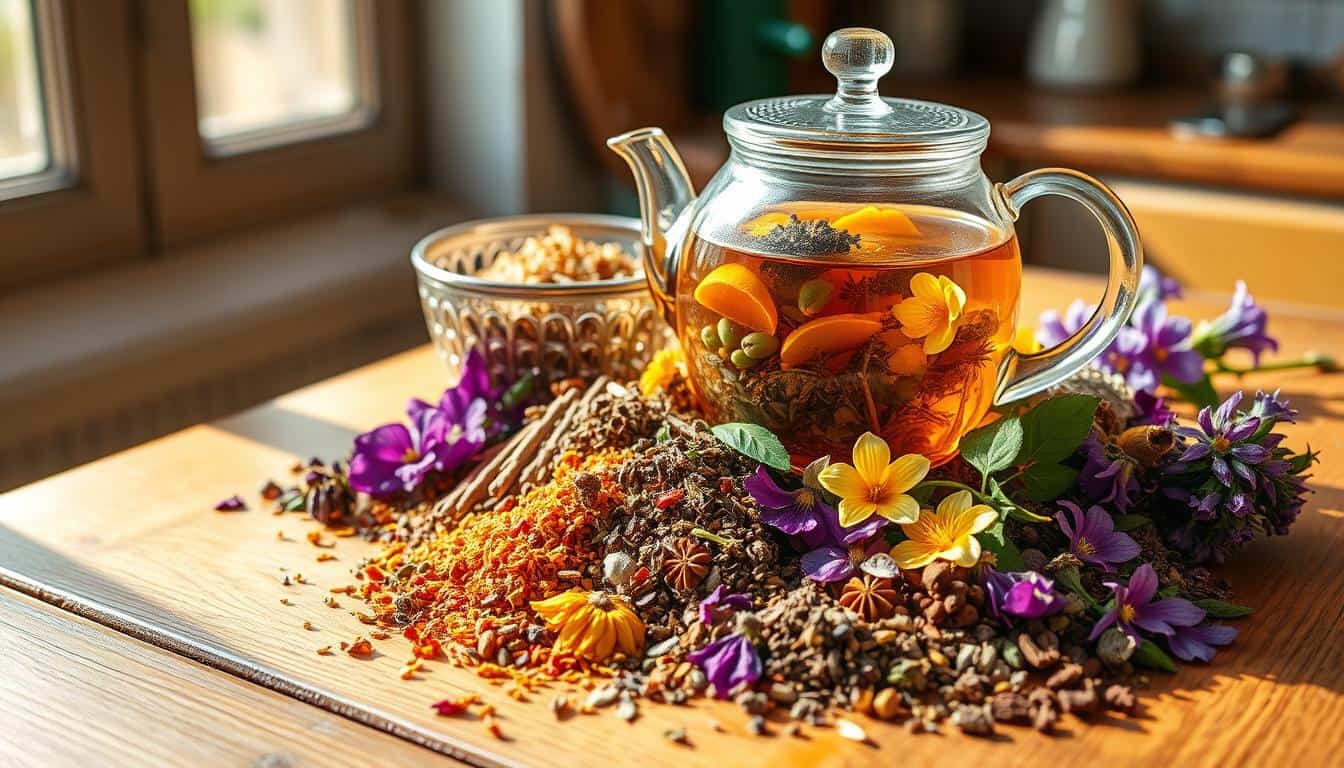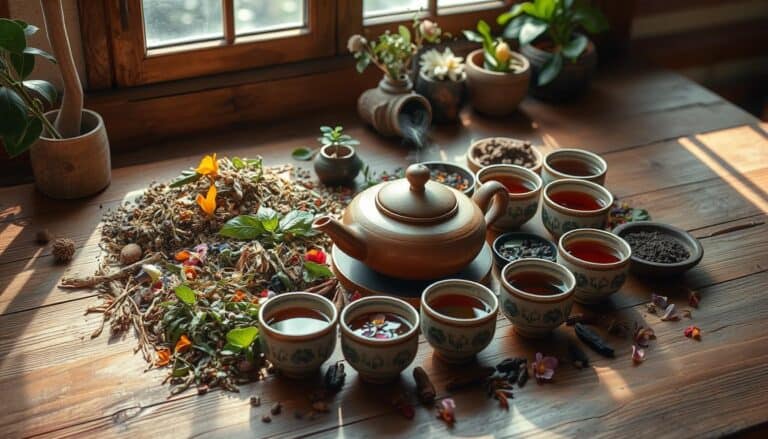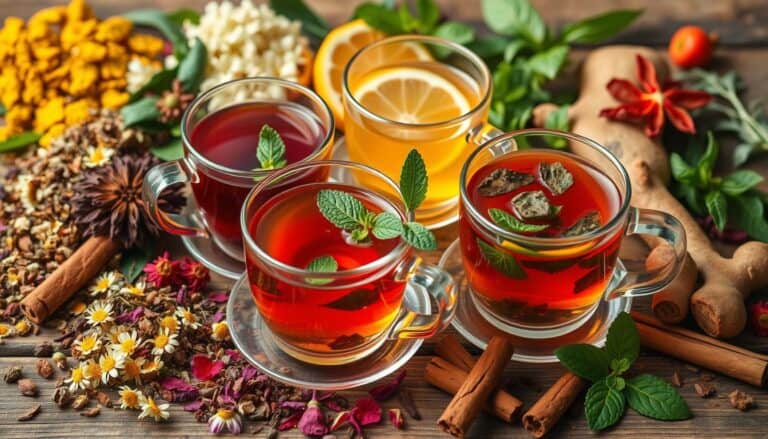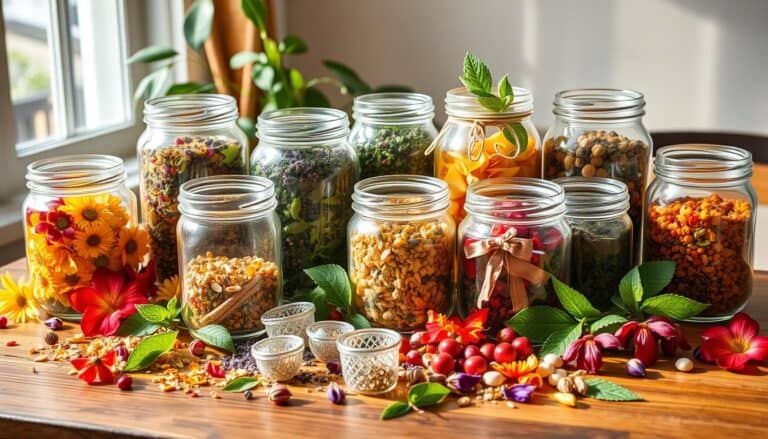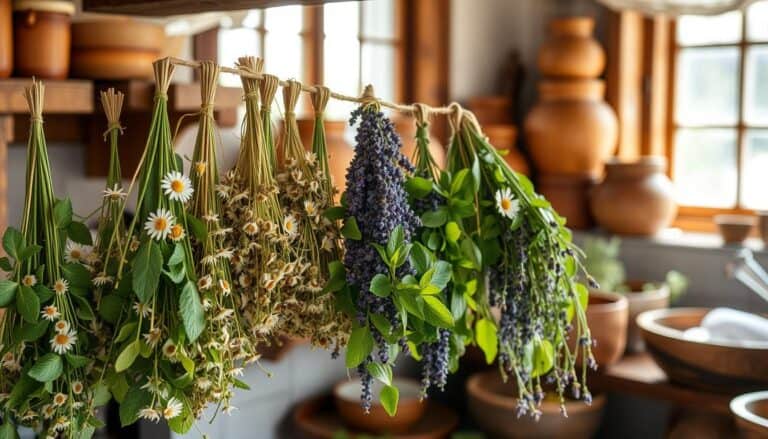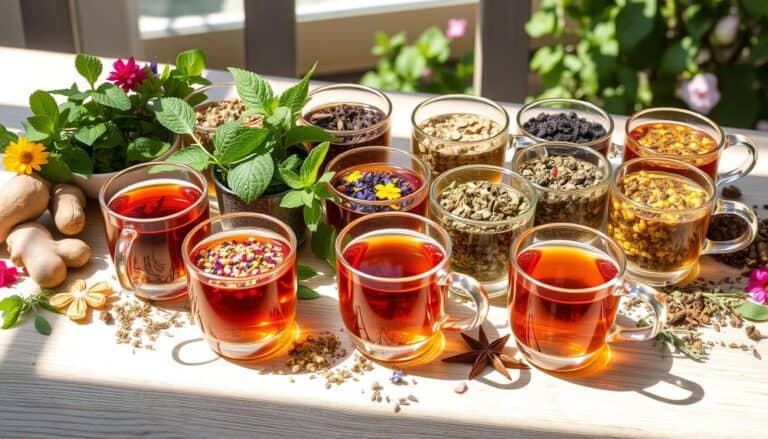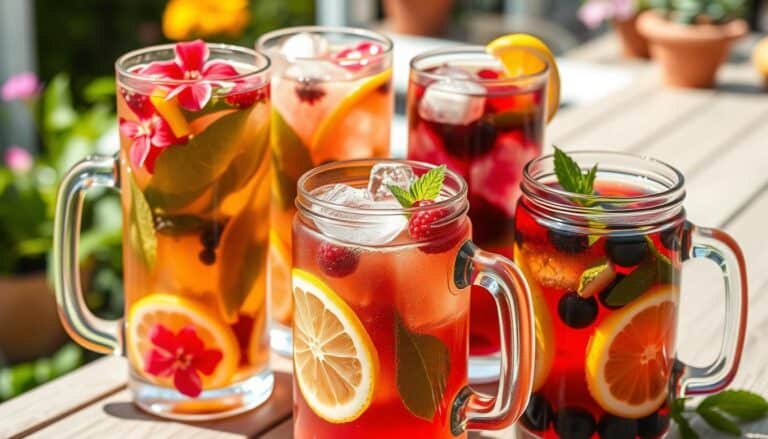Master the Art of Herbal Tea Blending
This post may contain affiliate links which means I may receive a commission for purchases made through links at no extra cost to you. I only recommend products I truly believe in. Thank you for your support!
Herbal tea blending is an ancient craft. It turns simple ingredients into powerful wellness elixirs. This tradition is more than just brewing—it’s about making personalized drinks that nourish both body and spirit.
Creating Herbal Tea Recipes requires understanding flavors and therapeutic properties. Each blend has its own story. It combines herbs that complement and enhance each other’s natural qualities.
Choosing high-quality Herbal Tea Ingredients is key. Organic, pesticide-free herbs from trusted sources give the best results. Whether you want relaxation, energy, or immune support, the right mix can offer amazing benefits.
Professional tea blenders, like those at PAPER & TEA, spend up to a year perfecting a single blend. Their work shows that herbal tea blending is an art form. It needs creativity, knowledge, and passion.
From the soothing Relaxation Elixir with Chamomile and Lavender to the invigorating Energy Booster with Peppermint and Ginger, each blend offers a unique experience. Your tea blending adventure starts here—are you ready to explore the world of herbal infusions?
Understanding the Basics of Herbal Ingredients
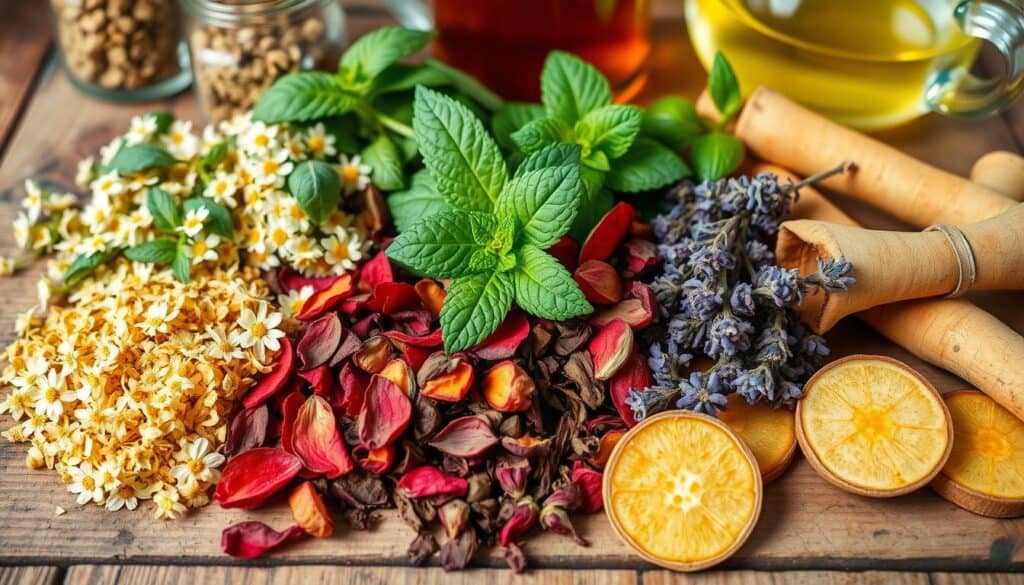
Herbal tea blending is an art that mixes nature’s best ingredients. It creates tasty and healthy drinks. This world of Herbal Tea Benefits is full of wellness and flavor. It invites tea lovers to try new tastes and natural healing.
Common Herbs and Their Benefits
Learning about different herbs is key when making herbal tea. Some top herbs include:
- Chamomile: Known for promoting relaxation and reducing stress
- Peppermint: Supports digestive health and provides refreshing flavor
- Ginger: Boosts immune system and offers warming sensations
- Echinacea: Strengthens immune response naturally
- Lavender: Aids sleep and reduces anxiety
Flavor Profiles of Popular Herbal Teas
Exploring Herbal Tea Flavors shows a wide range of tastes. From earthy and strong to light and floral, each herb adds something special to your blend.
| Herb | Flavor Profile | Primary Benefit |
|---|---|---|
| Chamomile | Mild, Sweet | Relaxation |
| Peppermint | Sharp, Cooling | Digestion Support |
| Hibiscus | Tart, Fruity | Heart Health |
Selecting Quality Ingredients
Choosing the best herbs is crucial for great herbal teas. Look for organic, pesticide-free herbs from trusted sources. Here are some tips:
- Purchase from local herbal markets
- Check for freshness and vibrant color
- Consider growing your own herbs
- Store herbs in airtight containers
Remember, the secret to amazing herbal tea is knowing each ingredient’s special qualities and health benefits.
Essential Tools for Blending Herbal Teas
Mastering herbal tea blending needs the right tools and knowledge. The right equipment turns amateur tea making into a professional art. To start making great herbal tea blends, you must know and pick the right tools.
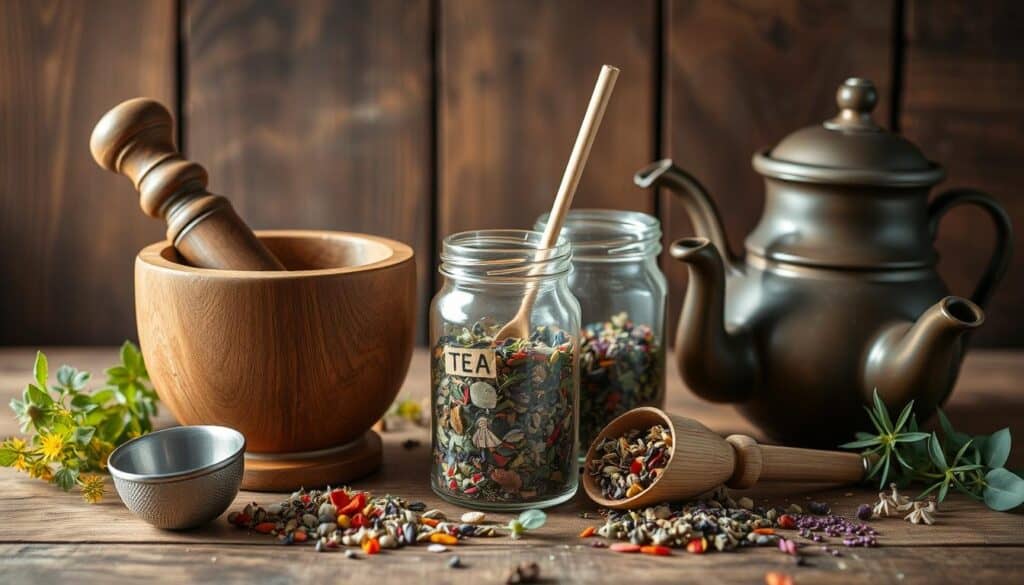
Must-Have Equipment for Tea Blending
For professional herbal tea blending, you need precision and quality tools. Your essential toolkit should include:
- Digital precision scale for accurate measurements
- Stainless steel mixing bowls
- Airtight glass storage containers
- Ceramic or glass tea scoops
- Fine mesh strainers
- Label maker for ingredient tracking
Measuring and Storing Ingredients
Getting the measurements right is key in herbal tea blending. The usual ratio for loose leaf tea is 1 teaspoon of dried tea per cup of water. For custom blends, follow these professional tips:
| Blend Component | Percentage |
|---|---|
| Base Tea Flavor | 70% |
| Complementary Flavors | 30% |
| Accent Flavors | 10% |
Keep herbs in dark, airtight containers away from moisture and sunlight. Always label containers with ingredient names, Latin botanical names, and harvest dates. This helps track freshness and potency.
Investing in quality tools and learning precise measurement techniques will boost your herbal tea blending skills. You’ll go from novice to expert.
Crafting Your Unique Blends
Herbal tea blending is a creative journey. It turns simple ingredients into amazing drinks. This art lets you explore flavors and create wellness rituals.
Techniques for Combining Herbs
To make great Herbal Tea Recipes, know how herbs work together. Here are some key tips for blending:
- Start with complementary flavor profiles
- Balance strong herbs with milder ingredients
- Experiment with different herb combinations
Balancing Flavors and Aromas
Making harmonious tea blends needs careful thought. Sensory exploration is key to creating unique infusions.
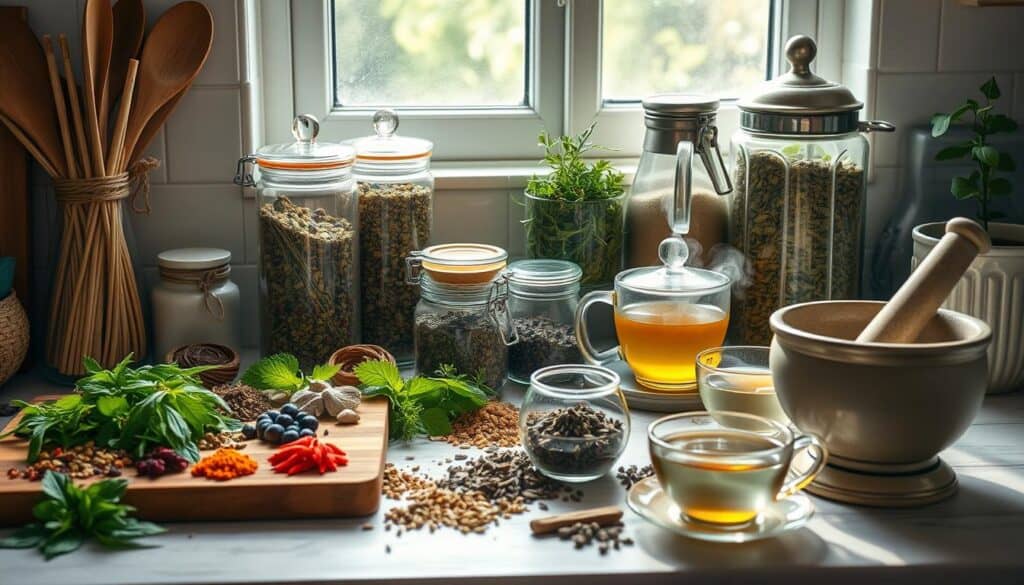
| Flavor Category | Recommended Herbs | Blending Purpose |
|---|---|---|
| Relaxation | Chamomile, Lavender, Lemon Balm | Calming and Stress Relief |
| Energy Boost | Peppermint, Ginger, Lemon Verbena | Enhancing Alertness |
| Immune Support | Echinacea, Elderberry, Rose Hips | Strengthening Immunity |
Experimenting with Ratios
The secret to great Herbal Tea Recipes is knowing how much of each ingredient to use. Start with small batches and adjust the ratios to find your perfect blend. A good starting point is one teaspoon of loose tea per 8 oz of water.
- Start with 3-4 complementary ingredients
- Taste and adjust gradually
- Keep detailed notes of your experiments
Tea blending is an art form that celebrates your creativity and wellness. Each blend has its own story of flavor, aroma, and purpose.
Health Considerations in Herbal Tea Blending
When exploring herbal tea benefits, it’s important to think about your health and how teas might interact with it. Learning about herbal ingredients can turn making tea into a way to improve your overall well-being.
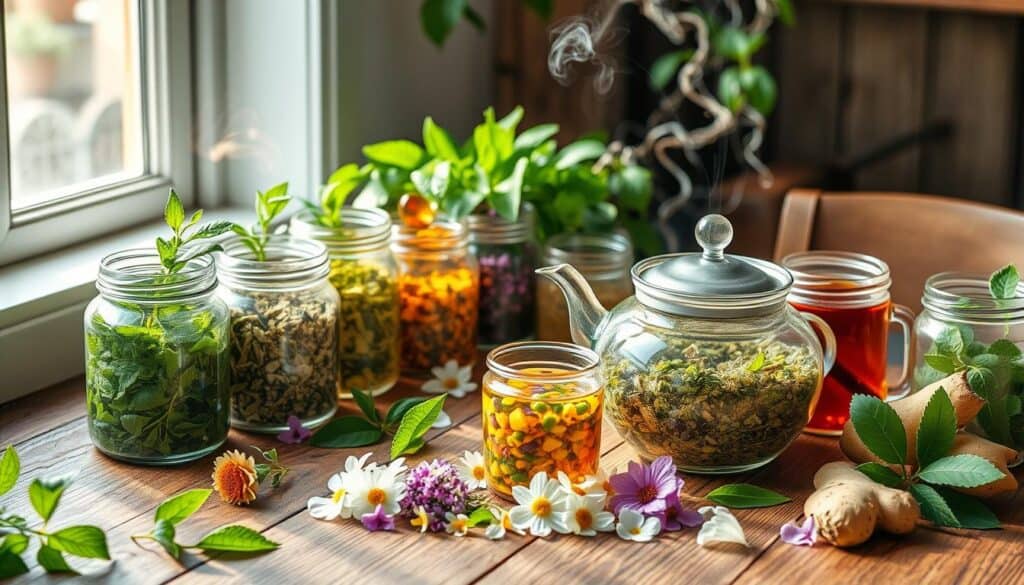
Potential Health Benefits
Herbal teas do more than just quench your thirst. They offer special health benefits:
- Chamomile helps reduce stress.
- Echinacea boosts your immune system.
- Peppermint can help with digestion.
- Ginkgo biloba improves mental focus.
Allergies and Sensitivities
It’s key to know your body’s health needs when enjoying herbal teas. Some people might react to certain herbs, so picking the right ones is important.
| Herb | Potential Sensitivity | Recommended Caution |
|---|---|---|
| Chamomile | Ragweed allergies | Conduct patch test |
| Echinacea | Autoimmune disorders | Consult healthcare professional |
| Ginger | Blood thinning medications | Discuss with doctor |
Consulting with a Herbalist
Professional guidance is essential for getting the most out of herbal teas. A skilled herbalist can give you advice that fits your health needs, making sure your tea blends are safe and effective.
Herbalists can guide you through the complex world of herbs. They suggest the right blends and support your health journey with careful tea choices.
Brewing the Perfect Herbal Tea
Mastering Herbal Tea Brewing Methods takes patience and precision. It’s more than just steeping leaves in hot water. It’s about finding the right mix of ingredients, temperatures, and techniques to make a wonderful wellness drink.
Optimal Brewing Times and Temperatures
Different herbal blends need different brewing methods. Here’s a guide to help you explore the world of Herbal Tea Brewing Methods:
- Relaxation Blends: Steep for 15-20 minutes with water just below boiling.
- Energy Support Blends: Infuse for 20 minutes with the right water temperature.
- Immune Boosting Blends: Steep for 20 minutes for the best extraction.
Best Practices for Tea Preparation
Professional tea brewers suggest certain techniques to improve your herbal tea:
- Use one teaspoon to one tablespoon of herb blend per cup.
- Choose organic, pesticide-free herbs for the best flavor.
- Heat filtered water to the right temperature.
- Cover your brewing vessel to keep oils and flavors in.
Enhancing Flavor with Additives
Try adding natural flavor enhancers to your herbal tea. Consider using:
- Fresh honey for sweetness.
- Lemon slices for brightness.
- Cinnamon sticks for warmth.
- Fresh mint leaves for depth.
The beauty of Herbal Tea Brewing Methods is their flexibility. Each brew is a chance to create something special. You can mix flavors and enjoy wellness benefits with every cup.
Sharing and Enjoying Your Creations
Making unique herbal tea blends opens a world of flavors and connections. Your homemade teas become more than drinks; they’re experiences to share. The Herbal Tea Pairing Guide helps you introduce your teas to friends and family.
Hosting a tea tasting event is a great way to show off your teas. Choose a few blends and prepare small samples. Match each tea with foods that bring out its flavors. For example, chamomile tea goes well with light cookies, while hibiscus tea pairs with spicy snacks.
When you give herbal teas as gifts, how you present them matters. Use nice containers with clear labels and brewing tips. Think about the person’s taste and health needs. A good Herbal Tea Pairing Guide can make the gift even more special, creating a unique experience.
Virtual tea blending sessions are another fun way to share your love for tea. You can connect with tea fans worldwide, teaching them how to blend teas. These sessions not only share knowledge but also build a community of tea enthusiasts.
